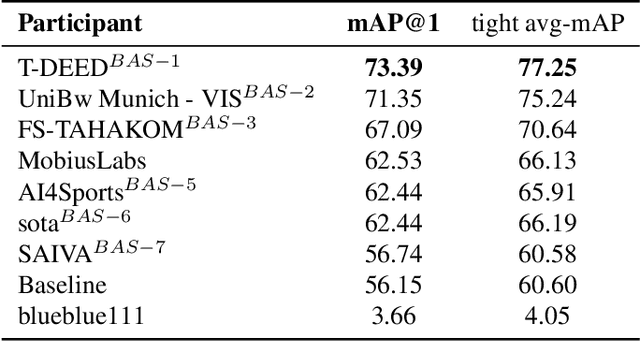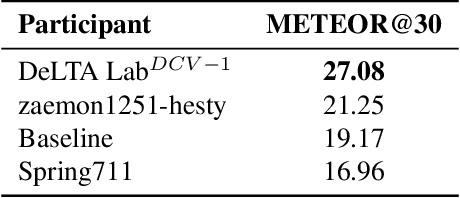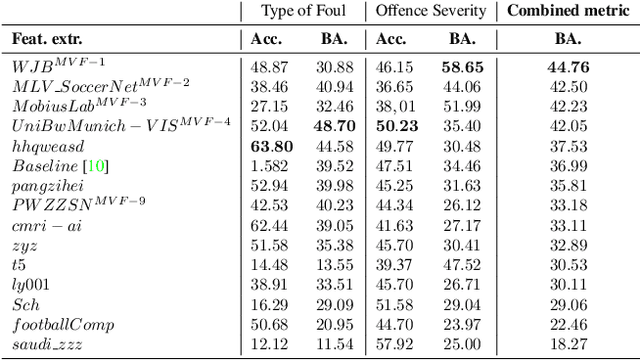Christophe De Vleeschouwer
UCLouvain
Few-Shot Adaptation Benchmark for Remote Sensing Vision-Language Models
Oct 08, 2025Abstract:Remote Sensing Vision-Language Models (RSVLMs) have shown remarkable potential thanks to large-scale pretraining, achieving strong zero-shot performance on various tasks. However, their ability to generalize in low-data regimes, such as few-shot learning, remains insufficiently explored. In this work, we present the first structured benchmark for evaluating few-shot adaptation methods on RSVLMs. We conduct comprehensive experiments across ten remote sensing scene classification datasets, applying five widely used few-shot adaptation strategies to three state-of-the-art RSVLMs with varying backbones. Our findings reveal that models with similar zero-shot performance can exhibit markedly different behavior under few-shot adaptation, with some RSVLMs being inherently more amenable to such adaptation than others. The variability of performance and the absence of a clear winner among existing methods highlight the need for the development of more robust methods for few-shot adaptation tailored to RS. To facilitate future research, we provide a reproducible benchmarking framework and open-source code to systematically evaluate RSVLMs under few-shot conditions. The source code is publicly available on Github: https://github.com/elkhouryk/fewshot_RSVLMs
NeRF-based Visualization of 3D Cues Supporting Data-Driven Spacecraft Pose Estimation
Sep 18, 2025Abstract:On-orbit operations require the estimation of the relative 6D pose, i.e., position and orientation, between a chaser spacecraft and its target. While data-driven spacecraft pose estimation methods have been developed, their adoption in real missions is hampered by the lack of understanding of their decision process. This paper presents a method to visualize the 3D visual cues on which a given pose estimator relies. For this purpose, we train a NeRF-based image generator using the gradients back-propagated through the pose estimation network. This enforces the generator to render the main 3D features exploited by the spacecraft pose estimation network. Experiments demonstrate that our method recovers the relevant 3D cues. Furthermore, they offer additional insights on the relationship between the pose estimation network supervision and its implicit representation of the target spacecraft.
SoccerNet 2025 Challenges Results
Aug 26, 2025Abstract:The SoccerNet 2025 Challenges mark the fifth annual edition of the SoccerNet open benchmarking effort, dedicated to advancing computer vision research in football video understanding. This year's challenges span four vision-based tasks: (1) Team Ball Action Spotting, focused on detecting ball-related actions in football broadcasts and assigning actions to teams; (2) Monocular Depth Estimation, targeting the recovery of scene geometry from single-camera broadcast clips through relative depth estimation for each pixel; (3) Multi-View Foul Recognition, requiring the analysis of multiple synchronized camera views to classify fouls and their severity; and (4) Game State Reconstruction, aimed at localizing and identifying all players from a broadcast video to reconstruct the game state on a 2D top-view of the field. Across all tasks, participants were provided with large-scale annotated datasets, unified evaluation protocols, and strong baselines as starting points. This report presents the results of each challenge, highlights the top-performing solutions, and provides insights into the progress made by the community. The SoccerNet Challenges continue to serve as a driving force for reproducible, open research at the intersection of computer vision, artificial intelligence, and sports. Detailed information about the tasks, challenges, and leaderboards can be found at https://www.soccer-net.org, with baselines and development kits available at https://github.com/SoccerNet.
Vocabulary-free few-shot learning for Vision-Language Models
Jun 04, 2025Abstract:Recent advances in few-shot adaptation for Vision-Language Models (VLMs) have greatly expanded their ability to generalize across tasks using only a few labeled examples. However, existing approaches primarily build upon the strong zero-shot priors of these models by leveraging carefully designed, task-specific prompts. This dependence on predefined class names can restrict their applicability, especially in scenarios where exact class names are unavailable or difficult to specify. To address this limitation, we introduce vocabulary-free few-shot learning for VLMs, a setting where target class instances - that is, images - are available but their corresponding names are not. We propose Similarity Mapping (SiM), a simple yet effective baseline that classifies target instances solely based on similarity scores with a set of generic prompts (textual or visual), eliminating the need for carefully handcrafted prompts. Although conceptually straightforward, SiM demonstrates strong performance, operates with high computational efficiency (learning the mapping typically takes less than one second), and provides interpretability by linking target classes to generic prompts. We believe that our approach could serve as an important baseline for future research in vocabulary-free few-shot learning. Code is available at https://github.com/MaxZanella/vocabulary-free-FSL.
CAMELTrack: Context-Aware Multi-cue ExpLoitation for Online Multi-Object Tracking
May 02, 2025Abstract:Online multi-object tracking has been recently dominated by tracking-by-detection (TbD) methods, where recent advances rely on increasingly sophisticated heuristics for tracklet representation, feature fusion, and multi-stage matching. The key strength of TbD lies in its modular design, enabling the integration of specialized off-the-shelf models like motion predictors and re-identification. However, the extensive usage of human-crafted rules for temporal associations makes these methods inherently limited in their ability to capture the complex interplay between various tracking cues. In this work, we introduce CAMEL, a novel association module for Context-Aware Multi-Cue ExpLoitation, that learns resilient association strategies directly from data, breaking free from hand-crafted heuristics while maintaining TbD's valuable modularity. At its core, CAMEL employs two transformer-based modules and relies on a novel association-centric training scheme to effectively model the complex interactions between tracked targets and their various association cues. Unlike end-to-end detection-by-tracking approaches, our method remains lightweight and fast to train while being able to leverage external off-the-shelf models. Our proposed online tracking pipeline, CAMELTrack, achieves state-of-the-art performance on multiple tracking benchmarks. Our code is available at https://github.com/TrackingLaboratory/CAMELTrack.
Learning Joint Denoising, Demosaicing, and Compression from the Raw Natural Image Noise Dataset
Jan 15, 2025



Abstract:This paper introduces the Raw Natural Image Noise Dataset (RawNIND), a diverse collection of paired raw images designed to support the development of denoising models that generalize across sensors, image development workflows, and styles. Two denoising methods are proposed: one operates directly on raw Bayer data, leveraging computational efficiency, while the other processes linear RGB images for improved generalization to different sensors, with both preserving flexibility for subsequent development. Both methods outperform traditional approaches which rely on developed images. Additionally, the integration of denoising and compression at the raw data level significantly enhances rate-distortion performance and computational efficiency. These findings suggest a paradigm shift toward raw data workflows for efficient and flexible image processing.
Online Gaussian Test-Time Adaptation of Vision-Language Models
Jan 08, 2025Abstract:Online test-time adaptation (OTTA) of vision-language models (VLMs) has recently garnered increased attention to take advantage of data observed along a stream to improve future predictions. Unfortunately, existing methods rely on dataset-specific hyperparameters, significantly limiting their adaptability to unseen tasks. In response, we propose Online Gaussian Adaptation (OGA), a novel method that models the likelihoods of visual features using Gaussian distributions and incorporates zero-shot priors into an interpretable Maximum A Posteriori (MAP) estimation framework with fixed hyper-parameters across all datasets. We demonstrate that OGA outperforms state-of-the-art methods on most datasets and runs. Additionally, we show that combining OTTA with popular few-shot techniques (a practical yet overlooked setting in prior research) is highly beneficial. Furthermore, our experimental study reveals that common OTTA evaluation protocols, which average performance over at most three runs per dataset, are inadequate due to the substantial variability observed across runs for all OTTA methods. Therefore, we advocate for more rigorous evaluation practices, including increasing the number of runs and considering additional quantitative metrics, such as our proposed Expected Tail Accuracy (ETA), calculated as the average accuracy in the worst 10% of runs. We hope these contributions will encourage more rigorous and diverse evaluation practices in the OTTA community. Code is available at https://github.com/cfuchs2023/OGA .
Realistic Test-Time Adaptation of Vision-Language Models
Jan 07, 2025



Abstract:The zero-shot capabilities of Vision-Language Models (VLMs) have been widely leveraged to improve predictive performance. However, previous works on transductive or test-time adaptation (TTA) often make strong assumptions about the data distribution, such as the presence of all classes. Our work challenges these favorable deployment scenarios, and introduces a more realistic evaluation framework, including: (i) a variable number of effective classes for adaptation within a single batch, and (ii) non-i.i.d. batches of test samples in online adaptation settings. We provide comprehensive evaluations, comparisons, and ablation studies that demonstrate how current transductive or TTA methods for VLMs systematically compromise the models' initial zero-shot robustness across various realistic scenarios, favoring performance gains under advantageous assumptions about the test samples' distributions. Furthermore, we introduce StatA, a versatile method that could handle a wide range of deployment scenarios, including those with a variable number of effective classes at test time. Our approach incorporates a novel regularization term designed specifically for VLMs, which acts as a statistical anchor preserving the initial text-encoder knowledge, particularly in low-data regimes. Code available at https://github.com/MaxZanella/StatA.
SoccerNet 2024 Challenges Results
Sep 16, 2024



Abstract:The SoccerNet 2024 challenges represent the fourth annual video understanding challenges organized by the SoccerNet team. These challenges aim to advance research across multiple themes in football, including broadcast video understanding, field understanding, and player understanding. This year, the challenges encompass four vision-based tasks. (1) Ball Action Spotting, focusing on precisely localizing when and which soccer actions related to the ball occur, (2) Dense Video Captioning, focusing on describing the broadcast with natural language and anchored timestamps, (3) Multi-View Foul Recognition, a novel task focusing on analyzing multiple viewpoints of a potential foul incident to classify whether a foul occurred and assess its severity, (4) Game State Reconstruction, another novel task focusing on reconstructing the game state from broadcast videos onto a 2D top-view map of the field. Detailed information about the tasks, challenges, and leaderboards can be found at https://www.soccer-net.org, with baselines and development kits available at https://github.com/SoccerNet.
Enhancing Remote Sensing Vision-Language Models for Zero-Shot Scene Classification
Sep 01, 2024


Abstract:Vision-Language Models for remote sensing have shown promising uses thanks to their extensive pretraining. However, their conventional usage in zero-shot scene classification methods still involves dividing large images into patches and making independent predictions, i.e., inductive inference, thereby limiting their effectiveness by ignoring valuable contextual information. Our approach tackles this issue by utilizing initial predictions based on text prompting and patch affinity relationships from the image encoder to enhance zero-shot capabilities through transductive inference, all without the need for supervision and at a minor computational cost. Experiments on 10 remote sensing datasets with state-of-the-art Vision-Language Models demonstrate significant accuracy improvements over inductive zero-shot classification. Our source code is publicly available on Github: https://github.com/elkhouryk/RS-TransCLIP
 Add to Chrome
Add to Chrome Add to Firefox
Add to Firefox Add to Edge
Add to Edge